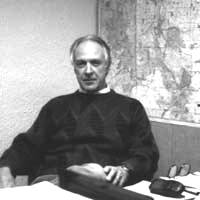Mark Morgan still looking preppy while at Lewis & Clark College.
Mark Morgan was the "prince
of parking" in high school, not realizing his destiny was a
Sisyphus parking career.
 | ||||
Biographical Sketches and Photos Supplied by '60 Classmates
Vol. 50, No. 1 FERN CREEK, KENTUCKY - Location of Friendliest School in the County October 3, 2010
In 1962, Walt landed a job on the assembly line at International Harvester and married Kay Cundiff, his high school sweetheart. While working on the line, he noticed some guys standing around drinking coffee.
In 1984, Harvester closed its Louisville plant in and Walt helped union members find new jobs. CNN heard about the program and interviewed Walt, who continued to climb the ladder after 25-years at Harvester; but, one day while on a 40-foot extension ladder, painting a house, he looked down and wondered, “What would happen if I fell?”
After getting out of the hospital, a friend called about a man who had two businesses. He wondered if Walt would be interested in a sales job for a company that stored documents and other items for companies.
An uncle came up with about four thousand dollars. Walt’s parents and friends delivered the rest and he bought controlling interest in the company.
Walt has turned the storefront operation into a thriving records storage company employing 14 people, including his son and daughter. The Papa John’s Pizza chain stores its records in a climate-controlled underground vault at the plant, on Bittersweet Road just off Bishop Lane, in Louisville. Jewish Hospital, Norton Hospital and the U.S. Army Corps of Engineers are among other clients.
Information Resources Inc. is also in the scanning business, but Walt says he can store a box of records for 30 years for what it costs his daughter to scan them into the system.
Retirement is far down the road for Walt Larmee. He loves going to work, “because I learn something everyday.”
Facing the draft, Lindsey joined the U.S. Army in 1966, in hopes of becoming an ordnance officer; but, when he saw tanks in action at Fort Knox, he wanted to go to become an armor officer. Then, Lindsey lost his love of slow-moving heavy tanks when he saw what armored reconnaissance platoons were capable of doing on the battlefield.
Following Officers Candidate School, Second Lieutenant Lindsey reported to Fort Hood, Texas, home of the 1st U.S. Cavalry. It was there he volunteered to help form an armored reconnaissance unit for deployment to Vietnam. Training lasted eight months.
November, 1967 found Lt. Lindsey at Landing Zone Ross, a former Marine firebase near the southern end of the Que Son Valley on the Laotian border. Lindsey was unaware of the danger lurking in the dense jungle surrounding the firebase, when the unit he commanded was ordered to escort a section of 8-inch self-propelled howitzers to the firebase.
“Almost immediately, we got into a running gun battle with a squad of NVA soldiers,” said Lindsey, who called in air strikes, as he pursued the enemy to its training base. What he didn’t know was his 50 men were actually facing 2,000 heavily-armed NVA troops. The battle lasted three days.
Looking back on the past 50 years, Jim Lindsey, who isn’t really retired, says it was a tremendous gift to be able to grow up in the 1950s.
Walter and Kay Larmee
Jim Lindsey
CLASS CLOWN TO FIRST CLASS BUSINESSMAN
FROM LIEUTENANT TO COMMANDING GENERAL
Submitted by Peggy Karem McClusky
Add Peggy Karem McClusky's name to the roster of distinguished educators spawned by the FCHS Class of 1960. Peggy had a rewarding, diversified career.
by Ross Simpson
by Ross Simpson



